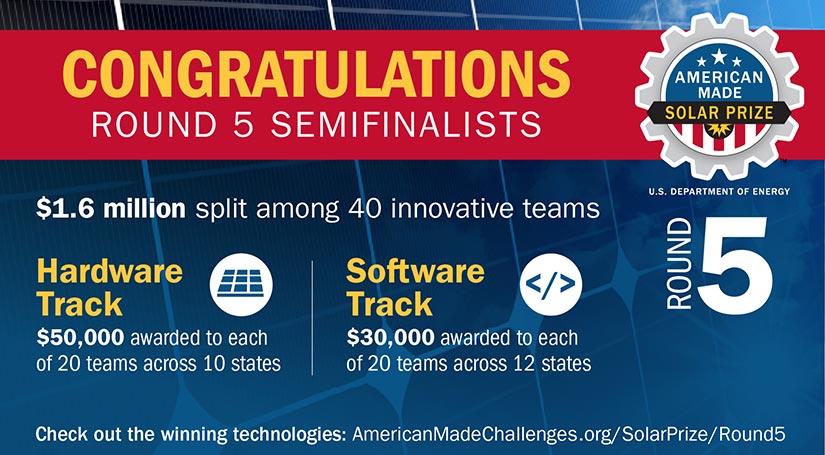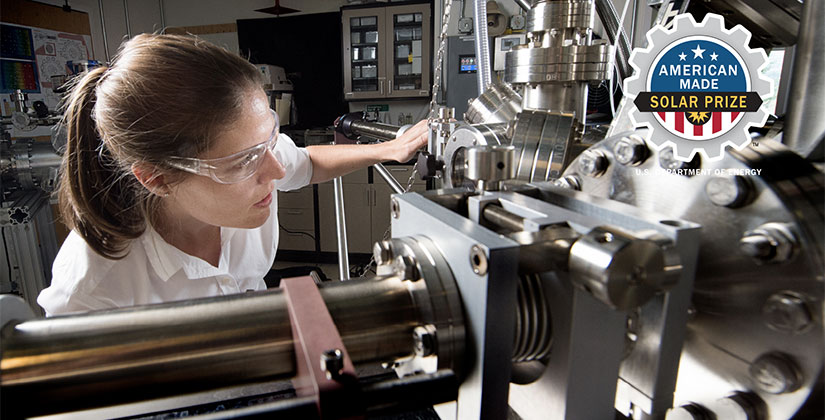40 Semifinalists Chosen To Compete in American-Made Solar Prize Round 5

Today, the U.S. Department of Energy (DOE) selected 40 semifinalists from 16 states to advance to the next contest in the American-Made Solar Prize Round 5, a competition designed to spark U.S. solar energy innovation. Unlike previous rounds of the Solar Prize, which focused solely on solar manufacturing and hardware components, Round 5 has two tracks—one for hardware and another for software—allowing even more innovators and entrepreneurs to compete.
Teams in the Hardware Track were each awarded $50,000, and teams in the Software Track were each awarded $30,000. Teams in both tracks participate in three consecutive contests: Ready!, Set!, and Go!. In the Ready! Contest, competitors submitted a game-changing solar energy idea, showed they had assembled a strong team, and put together an achievable plan. The semifinalists announced today will advance to the Set! Contest, in which they will develop either an early-stage proof of concept (in the Hardware Track) or a minimum viable product (in the Software Track).
"By turning the Solar Prize Round 5 into two tracks, we were able to expand our scope and bring in more innovative prize submissions than ever before," said Garrett Nilsen, acting director for DOE's Solar Energy Technologies Office. "This enabled software competitors to join for the first time, further increasing the impact these tools are having on the solar industry and expanding the number of customers that can benefit from solar."
Teams in the Software Track also had the option to compete in a new Justice, Equity, Diversity, and Inclusion (JEDI) Contest. The JEDI Contest awarded eight teams an additional prize for developing solutions that enable underserved communities to overcome systemic barriers to solar deployment.
"There are clearly many issues facing solar deployment in underserved and underrepresented communities, and many of our Ready! winners are tackling these challenges head-on," said Debbie Brodt-Giles, program administrator at the National Renewable Energy Laboratory. "Some of the barriers to accelerating the growth of solar in underserved communities can be overcome with software and business model innovations to help access financing, allocate the benefits of shared assets, improve customer outreach and engagement, and streamline development of relevant solar projects. Overall, we were very impressed with the quality and creativity of the hardware, software, and JEDI solutions."
The Round 5 semifinalist teams include:
Hardware Track

Photovoltaics
- Arcadia SR, Simplifying Residential Solar to a Single Product (El Sobrante, California) – This solar panel, designed for residential use, simplifies the ordering and installation process by combining the racking, flashing, hardware, and power electronics into a single product.
- Bio-Inspired 3D-Printed Concrete Anchors for Floating Photovoltaics (Los Angeles, California) – This team is developing 3D-printed concrete gravity anchors that are manufactured on-site for floating solar panel installations. This allows for the production of optimized anchor designs for each solar system.
- Integrated Greenhouse for Food and Clean Water (East Lansing, Michigan) – This team is developing an integrated greenhouse with a flat, transparent solar heater roof and a water treatment system. This integrated system uses heat absorbed from the solar thermal panels on the roof to generate clean water for use in the greenhouse.
- Optimizing Landfill Solar Power Production and Return on Investment (Derry, New Hampshire) – This team is developing a photovoltaic module racking solution for use on capped landfills. Their ballasted racking system can be deployed on steep slopes and avoids puncturing the landfill's protective cap.
- Patina: Solar That Works in the Shade (San Mateo, California) – This team is developing a technology to reduce the impact of shading on the performance of solar panels. Reducing shading allows this technology to use previously wasted energy to increase total energy generation.
- Portable Solar Carport With Integrated Electric Vehicle Charger (Sarasota, Florida) – This team's portable carport has an integrated solar PV system and electric vehicle charger and can be stored in a garage during periods of harsh weather.
- Rapid Deployment Hybrid Microgrid (Nashville, Tennessee) – This team is developing a self-contained hybrid microgrid system. This system combines solar arrays on accordion-style racking, batteries, inverters, and other components into a single container.
- Roll-Formed Steel Frames for Photovoltaic Modules (Bend, Oregon) – This team is developing PV module frames manufactured using a roll-forming process. Compared to current frames made from extruded aluminum, these frames can reduce PV system costs due to cheaper materials and higher manufacturing speeds.
- Saving Water With Combined Solar and Agriculture (Scotts Valley, California) – This team's flexible solar panels can be used in hoop houses, which cover agricultural crops to reduce water loss from evaporation. The solar panels have a technology that optimizes which parts of the solar spectrum are used for plant growth and power production.
- Self-Assembled Solar for Half the Cost (Miami, Florida) – This team is developing a rooftop PV panel mounting system for homes that can easily be installed by the homebuilder on-site. This could reduce the cost of residential solar for manufactured homes.
- Solar-Powered Cooling, Heating, and Electricity (San Diego, California) – This technology uses solar energy to simultaneously provide power for cooling, heating, and electricity. This is achieved through an integrated system that converts heat into energy for cooling with photovoltaic-thermal panels and refrigeration technology.
- Spectrum Shifting Nanocoating (Hayward, California) – This nanoparticle coating can be applied to solar panels to increase efficiency by optimizing which parts of the solar light spectrum they absorb. The coating can also be applied to already installed solar panels.
- Sun Deck Solar Electric Vehicle Charging Station (Roswell, Georgia) – This team is developing a solar-powered electric vehicle charging station that utilizes a self-assembling design to reduce installation costs.
- Wafer-Free Crystalline Silicon Solar Cells (San Francisco, California) – This team is developing a silicon solar cell that uses silicon particles instead of traditional silicon wafers. These particle-based cells have the potential to be manufactured with a U.S. supply chain.
Systems Integration
- Artificial Intelligence Solar Site Controller Synchronizing Electric Vehicle Charging (Lahaina, Hawaii) – This team is developing a plug-and-play energy management system that synchronizes on-site solar energy generation with electric vehicle charging. This would help avoid charging electric vehicles from the grid during expensive peak hours.
- Power Electronics for the Next Generation of Photovoltaics (Albuquerque, New Mexico) – This team is developing power electronics that can optimize the energy production of more complex next-generation photovoltaic devices, such as four-terminal tandem solar cells.
- Riding the Solar Curve (Carlsbad, California) – This team is developing an energy storage system that combines repurposed electric vehicle batteries with a novel power conversion system and state-of-the-art battery controls. These battery controls enable the system to use different makes and models of electric vehicle batteries.
- Solactivator: Economical Backup Power for Blackouts (Fremont, California) – This solar backup power solution allows grid-tied residential solar systems to function during blackouts by using on-demand power sources like electric vehicle batteries, power stations, or generators. This device first uses available solar power to meet electricity demands to maximize backup power coming from clean energy sources.
- SolarSCADA: Modular SCADA Specific to Solar (Denver, Colorado) – This supervisory control and data acquisition (SCADA) system combines all the sensors, calibration, communication, and data feeds needed to operate a solar energy system into pretested and preconfigured standalone packages. The SCADA system is modular, so more packages can be installed as the solar site grows larger.
Concentrating Solar-Thermal Power
- Ten Thousand Splendid Suns (Orinda, California) – This concentrating solar-thermal power collector technology uses nanoparticles to precisely concentrate sunlight onto a receiver. This would enable solar energy to provide heat to industries like steel or concrete manufacturing.
Software Track

Finance and Business Models
- Accelerating Capital Into U.S. Commercial Solar (Pasadena, California) – This platform seeks to automate commercial property assessed clean energy (C-PACE) financing for the small- and mid-scale commercial sector, with a particular focus on multi-family housing developments in underserved communities. (JEDI Contest winner)
- Facilitating Donations of Second-Life Solar Panels (Sheridan, Wyoming) – This team is building a software platform to enable a marketplace for secondhand, decommissioned solar photovoltaic modules and other solar equipment, with a specific focus on donations to underserved communities. (JEDI Contest winner)
- Solar as a Tool for Building Community Wealth (Oakland, California) – This platform will support community-owned solar via a cooperative business model that allows communities to invest, build, co-own, and steward local renewable energy projects. (JEDI Contest winner)
- Solar Stewards Marketplace (Atlanta, Georgia) – This team is creating a marketplace for a social renewable energy credit (REC). This new type of REC will allow corporate purchasers to buy RECs produced in underserved communities, which may align better with their corporate missions. (JEDI Contest winner)
- The Solar Equity Platform (Boston, Massachusetts) – This platform connects larger solar installations that have surplus power generation with nonprofits and underserved consumers to enable easy peer-to-peer credit sharing. (JEDI Contest winner)
- Voluntary Carbon Offsets for Rooftop Solar (San Francisco, California) – This team is building a platform to connect consumers who want to purchase voluntary carbon offsets with high-impact rooftop solar projects in underserved communities. (JEDI Contest winner)
System Operations
- Democratizing Photovoltaic Monitoring at Community Scale (Atlanta, Georgia) – This operations and maintenance tool uses artificial intelligence to analyze solar power plant data and identify deterioration, faults, and failures.
- illu - Illuminating Operations and Maintenance for Distributed Solar (Sunnyvale, California) – This team is building a mobile and desktop workflow management tool to assist field technicians with distributed solar system operations and maintenance.
- Merging the Real and Digital Worlds Through a Cyber-Physical-Social Platform for Microgrids (Buffalo, New York) – This team is developing microgrid management software with a focus on the human element. This software will enable underserved and indigenous communities to monitor and interact with their solar systems to meet financial and quality-of-life goals. (JEDI Contest winner)
- Solar Nowcasting With Machine Learning (Honolulu, Hawaii) – This team is creating near-real-time solar irradiance forecasting algorithms. These algorithms leverage recent advances in satellite imagery and machine learning to understand and predict cloud shape and movement.
- Solarcast and Solarcheck (SC2) (San Antonio, Texas) – This team is developing a solar forecasting tool that uses energy production data from inverters and other data feeds to improve intraday solar forecasting and plant performance.
- SolarGrade: Enabling Superpowers for On-Site Teams (Carlsbad, California) – This team is building a workflow management platform to facilitate inspection, operations, and maintenance of photovoltaic systems using input from field technicians and data analytics.
System Design
- Sandbox Agrivoltaics: Design and Artificial Intelligence for Agriculture + Photovoltaic Design (Fort Collins, Colorado) – This team is building software to help design agrivoltaic projects, with a focus on simulating the microclimates under solar modules and predicting crop growth yields.
- Solar River: Covering and Powering Canals With Solar (Bisbee, Arizona) – This team is developing a software solution to automate and optimize the engineering and design of solar systems sited over irrigation canals.
- SolarSpace: Siting and Construction Optimization (Albuquerque, New Mexico) – This team is developing geospatial software to identify optimal sites for utility-scale solar that avoid challenging terrain. This will help avoid costly discoveries about site terrain that arise in the later stages of solar project development.
Other Analytical Tools
- Artificial Intelligence Power Management and Sizing Software Packages (Los Angeles, California) – This team is developing an artificial intelligence power management software platform to help size and operate solar systems with energy storage.
- Building a Climate Sustainable Solar Energy Future (Fremont, California) – This team is developing a tool that uses machine learning and artificial intelligence to predict weather patterns at any location and on any timescale to help utilities with system planning and operations.
- Photovoltaic Module Health Check Using Electroluminescence and Artificial Intelligence (Orlando, Florida) – This team is building software to automatically identify defects in photovoltaic modules by using machine vision to process electroluminescence images of the modules. This software could improve both module manufacturing and photovoltaic plant maintenance.
- SolarSpace E-Management Platform (Tucson, Arizona) – This team is developing a software platform to optimize tracking for concentrating solar power The platform utilizes machine learning algorithms and works with different types of hardware.
Workforce Development
- ECademy: Online School To Train Solar Installers (Baltimore, Maryland) – This team is developing a workforce training platform with a focus on candidates from underserved groups or communities. The platform includes a curriculum, certifications, and an income-sharing model to help with upfront training costs. (JEDI Contest winner)
Ten Set! Contest finalists in each track will be selected in April 2022. Each of the finalist teams in the Hardware Track will win $100,000 and those in the Software Track will win $60,000. These teams will also become eligible to compete in the final Go! Contest. The two winning teams in each track will receive $500,000 in the Hardware Track and $200,000 in the Software Track each.
About the Solar Prize
The Solar Prize is a multimillion-dollar prize competition funded by the U.S. Department of Energy Solar Energy Technologies Office and is designed to energize U.S. solar manufacturing through a series of contests and the development of a diverse and powerful support network that leverages national laboratories, energy incubators, and other resources across the country. It is one of many prizes within the American-Made Challenges program.
The American-Made Challenges incentivize the nation's entrepreneurs to reassert American leadership in the energy marketplace. These new challenges seek to lower the barriers U.S.-based innovators face in reaching commercialization by accelerating the cycles of learning from years to weeks while helping to create partnerships that connect entrepreneurs to the private sector and the network of DOE's national laboratories across the nation.
Learn more about the Solar Prize and subscribe to the American-Made Challenges Newsletter for updates on Round 5 and future opportunities to get involved.

